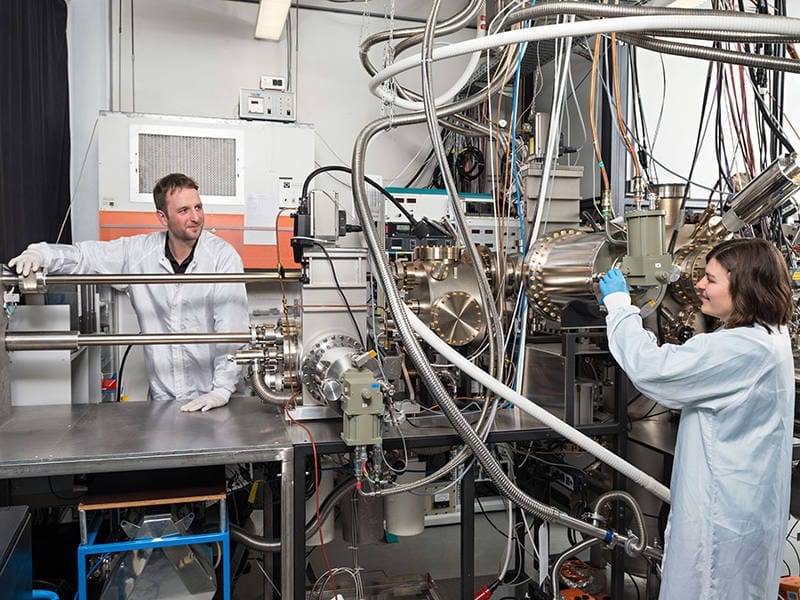
Technology could lead to new way of doing ‘lab on a chip’ medical diagnostics
Northwestern University scientists have developed the first liquid nanoscale laser. And it’s tunable in real time, meaning you can quickly and simply produce different colors, a unique and useful feature. The laser technology could lead to practical applications, such as a new form of a “lab on a chip” for medical diagnostics.
To understand the concept, imagine a laser pointer whose color can be changed simply by changing the liquid inside it, instead of needing a different laser pointer for every desired color.
In addition to changing color in real time, the liquid nanolaser has additional advantages over other nanolasers: it is simple to make, inexpensive to produce and operates at room temperature.
Nanoscopic lasers — first demonstrated in 2009 — are only found in research labs today. They are, however, of great interest for advances in technology and for military applications.
“Our study allows us to think about new laser designs and what could be possible if they could actually be made,” said Teri W. Odom, who led the research. “My lab likes to go after new materials, new structures and new ways of putting them together to achieve things not yet imagined. We believe this work represents a conceptual and practical engineering advance for on-demand, reversible control of light from nanoscopic sources.”
Odom is Board of Lady Managers of the Columbian Exposition Professor of Chemistry in the Weinberg College of Arts and Sciences.
The findings were published this week by the journal Nature Communications.
The liquid nanolaser in this study is not a laser pointer but a laser device on a chip, Odom explained. The laser’s color can be changed in real time when the liquid dye in the microfluidic channel above the laser’s cavity is changed.
The laser’s cavity is made up of an array of reflective gold nanoparticles, where the light is concentrated around each nanoparticle and then amplified. (In contrast to conventional laser cavities, no mirrors are required for the light to bounce back and forth.) Notably, as the laser color is tuned, the nanoparticle cavity stays fixed and does not change; only the liquid gain around the nanoparticles changes.
The main advantages of very small lasers are:
- They can be used as on-chip light sources for optoelectronic integrated circuits;
- They can be used in optical data storage and lithography;
- They can operate reliably at one wavelength; and
- They should be able to operate much faster than conventional lasers because they are made from metals.
Read more: Northwestern scientists develop first liquid nanolaser
The Latest on: Liquid nanolaser
[google_news title=”” keyword=”Liquid nanolaser” num_posts=”10″ blurb_length=”0″ show_thumb=”left”]
via Google News
The Latest on: Liquid nanolaser
- Spirit Airlines flight video shows unidentified liquid flowing down aisleon April 25, 2024 at 1:54 pm
An issue on a Spirit Airlines plane earlier this week sent liquid flowing through the aisle between rows of passengers, according to video and reports. The liquid seemingly started its path from ...
- Liquid assets: A complete guideon April 25, 2024 at 10:57 am
Here's the importance of liquid assets in financial planning and the role of liquid assets in business solvency. Quick tip: Invest in liquid assets like large-cap stocks, treasury bonds ...
- Shoppers rush to snap up £35 Paula's Choice 'holy grail' liquid exfoliant in under £8 dealon April 22, 2024 at 3:37 am
Everyone’s been talking about the viral liquid exfoliant from Paula’s Choice hailing it as a ‘holy grail’ product for transforming acne-prone skin. And we’ve just found a deal where if ...
- Spigen Liquid Air Samsung Galaxy S24 case review: Should you buy it?on April 18, 2024 at 5:00 pm
The Spigen Liquid Air for the Samsung Galaxy S24 is a superb thin case that offers basic protection in an attractive package. The Spigen Liquid Air for the Samsung Galaxy S24 is a superb thin case ...
- Can You Take Basil In Liquid Form? A Review By Nutrition Professionalson April 13, 2024 at 10:13 am
You can take basil in liquid form. To take basil in liquid form, it is simply processed with some type of oil or water. It can be used as a dressing or to prepare a sauce. → See more questions ...
- Liquid Death’s Billion-Dollar Valuation Stresses The Power Of Brandon March 20, 2024 at 4:30 am
I study culture's impact and influence on behavioral adoption. For many, Liquid Death's success is paradoxical. The company's core product does not offer an outstanding innovation regarding its ...
- Liquid vs. Powder Detergent vs. Pods: Which Is Best for Your Laundry?on March 10, 2024 at 5:01 pm
Laundry experts break down the pros and cons of powder vs. liquid detergent, as well as pods. Find out which is right for you. “All detergents have pros and cons,” says LaundryTok expert ...
- Liquid Handling News and Researchon March 7, 2024 at 4:00 pm
Revvity, Inc. (NYSE: RVTY) today announced the launch of the Auto-Pure 2400 liquid handler from Allsheng for use with the T-SPOT.TB test. The Auto-Pure 2400 platform is easy to use and designed ...
- Lesson 2.5 - The Density of Liquidson September 1, 2023 at 8:42 am
Students will be able to explain that the density of a liquid has to do with how heavy it is for the sample size. Students will also be able to explain that if a liquid is more dense than water, it ...
- The Matte Lipstick Revival Is Upon Uson June 16, 2023 at 10:25 pm
At Byredo, make-up artist Lucia Pica has launched a line of fluffy, light-as-air liquid lipsticks that look best when applied gently and smudged with a finger. They’ll last as long as you do ...
via Bing News










